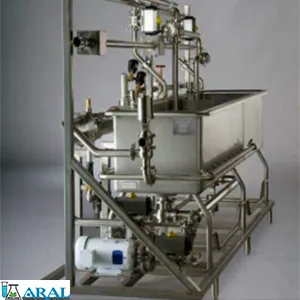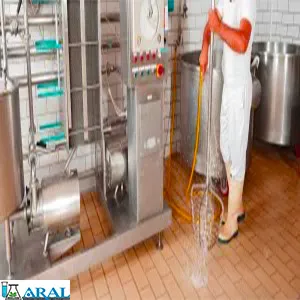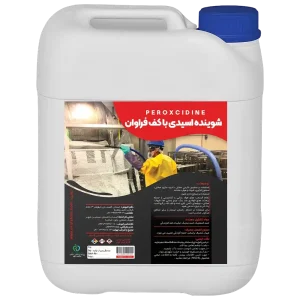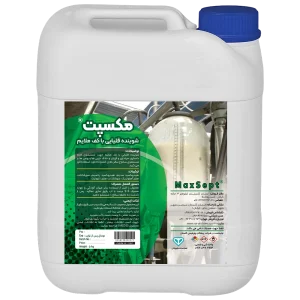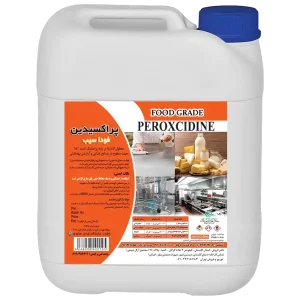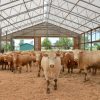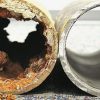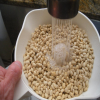اصول ضدعفونی و شستشوی سیستم COP
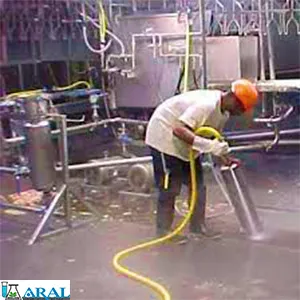
اصول ضدعفونی و شستشوی سیستم COP
تولیدکنندگان باید هزینه های تولید غذا، نوشیدنی، لوازم آرایشی و بهداشتی، داروسازی و سایر را پایین نگاه دارند. چراکه آلودگی محصول منجر به هدر رفتن تلاش و منابع میشود. همچنین، مسائل بهداشتی و ایمنی ایجاد میکند که میتواند اعتبار شرکت و اعتماد مشتری را به خطر بیندازد. از این رو، سیستم شستشوی COP وCIP تجهیزات فرآوری مواد غذایی برای تمیز کردن و ضدعفونی بهتر تجهیزات تولید نیاز است تا ایمنی مواد غذایی و کیفیت را افزایش دهد. همچنین فرآیند نظافت و شستن COP و CIP برای افزایش بهره وری ضروری است. در این مقاله مطالبی درباره شستشوی سیستم COP ارائه شده و محصولی مناسب جهت ضدعفونی سیستم COP معرفی خواهد شد.
COP چیست؟
سیستم های شستشوی خارج از محل (COP) برای تمیز کردن قطعاتی از تجهیزاتی که توسط سیستم شستشوی در محل (CIP) لمس نمی شوند، استفاده می شود. ضدعفونی سطوح خارجی COP تجهیزات میتواند شامل اتصالات، گیرهها، ظروف حمل محصول، دریچههای مخزن، روتور پمپ، پروانهها، محفظهها، شیلنگها و غیره باشد. همچنین میتوان از این نوع سیستم در شرایطی استفاده کرد که تجهیزات فرآیند برای تمیز کردن باید جدا شوند. معمولاً تمیز کردن تجهیزاتی که کوچک هستند، پیچیده یا دشوار است. سیستمهای COP همچنین میتوانند همراه با تمیز کردن دستی، استفاده شوند.
پیشنهاد می کنیم حتماً بخوانید:
♣ سیستم CIP و مکانیسم عملکرد آن
♣ ضدعفونی کننده های رایج در صنایع غذایی و لبنی و عملکرد آن ها
برخی از مزایای سیستم های COP
مزیت های سیستم COP به شرح زیر است:
- معمولاً سرمایه گذاری کمتری نسبت به سیستم های CIP دارد.
- نتایج ثابتی را ارائه می دهد.
- باعث صرفه جویی در هزینه نسبت به تمیز کردن دستی، صرفه جویی در زمان، مصرف مواد شیمیایی و آب می شود.
- قرار گرفتن اپراتور در معرض دماهای بالا و غلظت مواد شیمیایی قوی را به حداقل می رساند.
تفاوت COP و CIP
تفاوت بین شستشوی سیستم COP و CIP اساسا در تمیز کردن سطوح داخل و خارج است:
- CIP فرآیندی است که از شستشوی آب، بازگردانی سوزاننده داغ و یا اسید، دماهای دقیق و تلاطم برای تمیز کردن خاکها و باکتریها از سطوح داخلی تجهیزات تولید مواد غذایی (مانند لولهها، مخازن اختلاط، پمپها، دریچهها، مخازن ذخیرهسازی) استفاده میکند. تجهیزات دیگر اساساً شامل اتصال خط تولید به یک سیستم فلاشینگ مستقل و فشار دادن یک دکمه است.
- از سوی دیگر، یک سیستم COP از یک یا چند مخزن مستطیلی تشکیل شده است. این مخازن از پمپ ها، نازل های فشار قوی، مواد سوزاننده، اسیدها، آب گرم و گریس ساده زانویی قدیمی برای تمیز کردن سطوح بیرونی قطعات خارجی مانند شیلنگ ها، گیره ها استفاده می کند. قطعات باید برداشته و جدا شوند، تمیز شوند، سپس دوباره قرار داده شوند.
فرآیند ضدعفونی در صنایع غذایی
اهمیت به بهداشت، بخش مهمی از تولید مواد غذایی ایمن است. به همین دلیل است که سیستم های تمیز کردن جامد در محل و خارج از محل ضروری هستند. با تأکید بیشتر بر طراحی بهداشتی در کارخانههای مواد غذایی، تولیدکنندگان تجهیزات و صنعت با یکدیگر همکاری کردهاند تا پیشرفتهای زیادی در تجهیزات و قطعاتی ایجاد کنند که نظافت و ضدعفونیکردن را مؤثرتر میکند. معرفی یا بهبود روشها، فرآیندها و ضدعفونی کننده های صنایع غذایی CIP COP، از مزایای طراحی تجهیزات بهداشتی بهره میبرد و سطح اطمینان را افزایش میدهد. وقتی خط تولید برای اجرای جدید راهاندازی میشود، فرآیند ضدعفونی در صنایع غذایی از همان ابتدا تحت کنترل است.
ضدعفونی کردن و شستشوی COP در صنایع لبنی
اصول COP در صنایع غذایی شامل شستشو و ضدعفونی خطوط تولید انواع نوشیدنی ها، محصولات فرآوری شده، بسته بندی مواد غذایی، میوه و سبزیجات و غیره است. اولین مرحله در شستن COP صنایع لبنی، حذف خاک در زمانی است که تجهیزات به طور جزئی یا کامل از هم جدا شوند. حذف خاک با گردش محلول های شیمیایی و شستشو با آب در یک مخزن شستشو انجام می شود که ممکن است به پمپ های گردشی مجهز باشد. دومین گام در شستشوی سیستم COP محصولات لبنی، چربی زدایی از سیستم و شستن COP با استفاده از انواع شوینده های قلیایی با کف و با کف فراوان است.
کلام آخر:
به طورکلی، هر چه انجام کاری آسان تر باشد، احتمال انجام آن و انجام درست آن بیشتر می شود. افزایش اثربخشی سیستم CIP و COP کارخانجات مواد غذایی، توانایی کارخانه را برای سادهسازی فرآیند تمیز کردن، شستن COP و ضدعفونی کردن افزایش میدهد. برقراری ارتباط با تامین کنندگان محلول های شیمیایی مناسب برای شستشوی سیستم COP و CIP می تواند راندمان تولید را در بخش های مختلف صنایع غذایی و لبنی افزایش دهد. شرکت آرال شیمی با تولید محلول فودگرید و سطح بالای فوداسیب، قادر است ضدعفونی سیستم COP و CIP را به شکل مطمئن و کم هزینه انجام دهد.
⇐بروزرسانی شده در مهر 1402
-
شوینده اسیدی با کف فراوان
1201000تومان – 4555000تومان انتخاب گزینهها این محصول دارای انواع مختلفی می باشد. گزینه ها ممکن است در صفحه محصول انتخاب شوند -
شوینده قلیایی با کف فراوان
489000تومان – 1495000تومان انتخاب گزینهها این محصول دارای انواع مختلفی می باشد. گزینه ها ممکن است در صفحه محصول انتخاب شوند -
شوینده قلیایی با کف ملایم
317000تومان – 989000تومان انتخاب گزینهها این محصول دارای انواع مختلفی می باشد. گزینه ها ممکن است در صفحه محصول انتخاب شوند -
فوداسیب | پراستیک اسید 15% خوراکی
1050000تومان – 1950000تومان انتخاب گزینهها این محصول دارای انواع مختلفی می باشد. گزینه ها ممکن است در صفحه محصول انتخاب شوند

